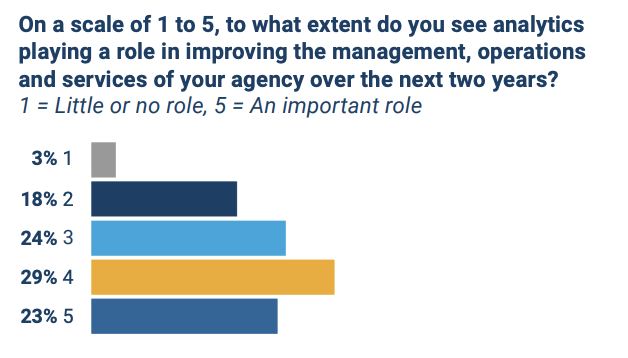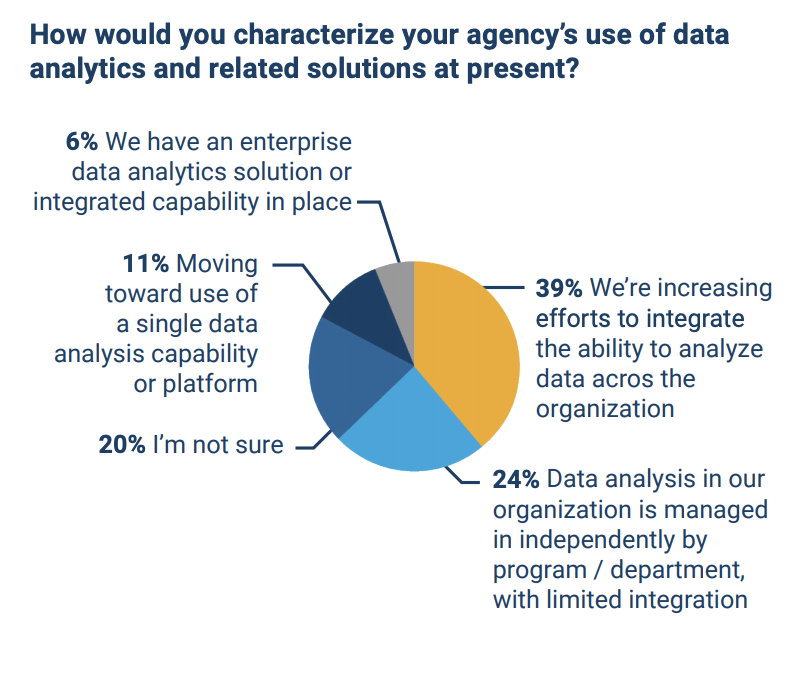Government agencies see IT innovation as the most efficient way to marshal their resources, improve internal and external services, and make good use of their endless troves of data.
But with agencies’ tight budgets, legacy systems, an arduous procurement process and the limits of in-house talent, they won’t get there alone. To better understand how agencies are driving more innovation, GovLoop partnered with SAP NS2 to survey 157 federal, state and local government employees about the obstacles they face and the solutions they are adopting.
When it comes to innovation, agencies are pinning much of their hopes on analytics, particularly when putting their vast stores of data to use.
With cloud as the platform, they could access data from a variety of sources and in a variety of formats. Agencies could use machine learning, artificial intelligence (AI) and other advanced tools to glean information to help improve services, make better decisions and fine-tune operations.

More than three-quarters of survey respondents said they saw an important role for analytics in improving management, operations and service, ranking it from 3 to 5 on the 1-5 scale. (See figure to the right)
Among uses for analytics, supporting collaborative decision making led the way, with 67% of respondents identifying that as a key point of interest. Not far behind were gaining deeper insights into the performance of agency operations (66%) and insight into services for internal and external customers (64%). Respondents also saw benefits in using ad hoc and what-if analyses to explore alternative courses of action (47%) and enabling users to create and share their predictive models (37%). (See figure below)

But they’re not there yet; when asked about their use of data analytics, 6% said they have an enterprise data analytics solution or integrated capability in place. Respondents were somewhat split on whether analytics would be an organizationwide activity. Thirty-nine percent said they’re increasing efforts to integrate analytics across the organization. Almost a quarter (24.4%) said a program or department independently manages data, with limited integration. Another 11% said they’re moving toward using a single data analysis capability or platform. (see figure to the left)
Cloud can provide access, since not all of an agency’s data will be in one place. Tools such as AI can clean unstructured data — which accounts for about 80% of what agencies have — identify patterns, locate applicable datasets and even offer recommendations for action.

AI.gov, launched by the White House last year, emphasizes the importance the federal government places on AI as a tool for everything from science and health care to manufacturing, agriculture and security, while stressing the need for collaboration and investment in AI R&D.
Analytics is an area in which agencies can pursue collaboration through open data sharing initiatives and take advantage of the most advanced tools available. Innovation by commercial providers of analytics software is evolving rapidly, and agencies could invite companies to demonstrate what’s possible with state-of-the-art technology.
By using advanced analytics tools, corporations have transitioned to real-time digital boardrooms for running their businesses. By embracing these technologies, government agencies can do the same.
The government’s data problems are not unique; the commercial world deals with the same trends. But by using advanced analytics tools, corporations have transitioned to real-time digital boardrooms for running their businesses. By embracing these technologies, government agencies can do the same.
This article is an excerpt from GovLoop’s recent research brief, “Accelerating the Adoption of Commercial Innovation in Government,” Download the full brief here to explore more results and learn how your agency can make its modernization goals a reality by embracing diverse communities of tech innovation through collaboration and investment.






Leave a Reply
You must be logged in to post a comment.